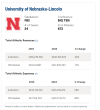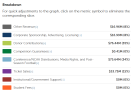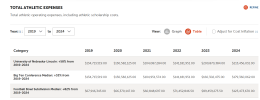Congress could soon introduce a very NCAA-friendly bill
The Post obtained copies of draft legislation from two House committees that addresses the priorities the NCAA has spent years lobbying for.
June 9, 2025 at 12:28 p.m. EDTToday at 12:28 p.m. EDT
By
Jesse Dougherty
Now that
a judge has approved the settlement of three major antitrust cases against the NCAA and power conferences, the political jostling over college sports legislation is expected to heat up on Capitol Hill.
The Washington Post obtained copies of draft legislation from two House committees, which would amount to a bill that checks off every item the NCAA has spent years — and millions of dollars — lobbying for: a preemption of state laws that conflict with rules set by the NCAA and/or its conferences; a prohibition on college athletes being classified as employees; and broad antitrust protection that lines up with the
House v. NCAA settlement approved Friday, which could insulate the NCAA and its members from legal challenges of a new salary cap for schools’ direct payments to athletes and attempts to regulate booster spending in the name, image and likeness (NIL) market.
Republican lawmakers first sent the drafts around last week, meaning there could be changes, subtle or substantial, before they are publicized. The main draft has been circulated by Republicans from the House’s Energy and Commerce committee (in conjunction with its subcommittee on commerce, manufacturing and trade). The subcommittee is holding a legislative hearing on college sports Thursday, which was announced as a session for the “SCORE Act to Standardize NIL for Student-Athletes.”
The main draft, which is expected to be introduced at that hearing, leaves a key spot for the House Judiciary committee to provide language on antitrust protection and a preemption of state laws. The Post obtained the Judiciary committee’s language, too.
As of Monday morning, it was unclear which lawmakers will put their names on the legislation draft (those spots were left blank in the obtained copies). The House’s Energy and Commerce committee is chaired by Brett Guthrie (R-Kentucky). The subcommittee for commerce, manufacturing and trade is chaired by Gus Bilirakis (R-Florida), who introduced a draft of a college sports bill in January 2024. The Judiciary committee is chaired by Jim Jordan (R-Ohio). But no matter who it is, it’s notable that Republicans from multiple House committees are working together on this. A half-dozen congressional staffers, who spoke on the condition of anonymity to discuss private negotiations, say they believe that’s the only way a college sports bill has a chance to move through the House. According to multiple people familiar with the discussions for this legislation, some House Republicans are also seeking involvement from the Education and the Workforce committee, particularly to ensure college athletes cannot become employees.
The draft language includes antitrust protection for:
- Preventing an associated entity or individual from providing a student-athlete compensation greater than fair market value for name, image and likeness agreements. (The House settlement establishes a clearinghouse — run with the help of Deloitte by the College Sports Commission, the entity formed by the power conferences to implement the settlement and enforce its rules — that will review any NIL deal that exceeds $600.)
- A school, conference or interstate association setting the maximum amount of money that can be distributed to athletes in a given year. (The House settlement establishes an initial spending cap of $20.5 million for money paid from schools to athletes in 2025-26. That cap is expected to rise throughout the decade-long legal agreement.)
- Limiting the eligibility of athletes based on the number of seasons played or years exhausted. (This is not part of the House settlement but would provide the NCAA with protection from a slew of antitrust lawsuits challenging eligibility rules.)
The draft goes on to outline additional antitrust protection for enforcing transfer rules and an agent registration process. Multiple athlete advocates say they believe the latter could create conflicts of interests if agents must be certified by the same people they are ultimately negotiating with on behalf of the athletes they represent. The NCAA currently has a voluntary registry for NIL agents.
Since the summer of 2021, there have been more than a dozen college sports hearings in Washington. To date, only one bill has reached a committee vote. There has otherwise been little traction toward legislation, though a small handful of senators have held many discussions about a bipartisan solution. Those conversations have mainly included Ted Cruz (R-Texas), Jerry Moran (R-Kansas), Cory Booker (D-New Jersey), Richard Blumenthal (D-Connecticut) and Chris Coons (D-Delaware).
Schools will start sharing revenue with athletes July 1 under the terms of the
House settlement, increasing the NCAA and power conferences’ urgency for legislation.
On Saturday, NCAA President Charlie Baker sent a letter to members of Congress, reiterating his organization’s main asks and hammering the need for action. The letter, obtained by The Post, outlined why the NCAA wants Congress to pass a bill “affirming student-athletes are not employees,” “providing limited liability protections” and “resolving conflicting state laws.”
All along, the NCAA’s plan has been to settle the
House,
Carter and
Hubbard lawsuits, then leverage that development on Capitol Hill, where lawmakers have historically been very skeptical of the NCAA’s push for antitrust protection and other measures. Baker, a former Republican governor of Massachusetts, was hired, at least in part,
for his track record of working with politicians on both sides of the aisle.
“With a new system in place for schools to greatly expand direct financial benefits to student-athletes, they are more modern and more future-ready than ever,” Baker wrote in his letter. “The progress we’ve made, especially with the House settlement, represents a significant step forward. And, in the narrow areas where we lack the authority needed to address outstanding issues, we look forward to working with you and your staff to advance solutions that will ensure that college sports continue to provide fair opportunities to all student-athletes, for generations to come.”
Rep. Lori Trahan (D-Massachusetts), a former Georgetown volleyball player, has been very involved in college sports discussions in Washington. On Saturday, Trahan released a statement commending the athletes who pushed for the progress resulting in schools paying athletes directly for the first time. But Trahan, a minority member of the House Energy and Commerce committee — and the subcommittee on commerce, manufacturing and trade — is not in favor of the congressional action the NCAA seeks.
“With this momentum, athletes can, and must, keep pushing. There’s much more work ahead to strengthen Title IX, ensure NIL rights extend to all college athletes, and center the health and safety of athletes in every conversation about reform,” Trahan said in her statement. “The greatest threat to that progress is misguided intervention by Congress that chokes off the hard-won gains athletes have fought to achieve. If Congress acts, it must focus on the actual challenges facing college athletics — not the balance sheets of powerful conferences.”
Once Republicans took control of the Senate, House and White House after November’s elections, it seemed the NCAA had an easier path to its desired bill. President Donald Trump’s overhaul of the National Labor Relations Board led multiple groups to pause efforts to have athletes recognized as employees. On Sunday, Trump golfed with SEC Commissioner Greg Sankey and Notre Dame Athletic Director Peter Bevacqua. The plan was to discuss the future of college sports, according to people familiar with the outing. The White House has kicked around forming a commission to explore that topic. On Monday morning, in a virtual news conference to discuss approval of the
House v. NCAA settlement, Sankey called for Congress to act on college sports. Expect those calls to come at an even faster pace.
And now on Thursday, the latest draft for a House bill would begin the post-settlement discussions on a very friendly note for the NCAA. But as the past few years have shown, the path to actual legislation will always be winding and complicated.


